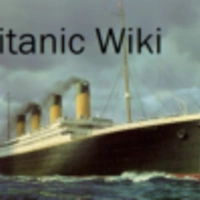Robert Hichens (September 16th, 1882 - September 23rd, 1940) was part of the deck crew on board the RMS Titanic when it sank on its maiden voyage on April 15th, 1912. He was one of 7 quartermasters on board the vessel and was at the ship's wheel when the Titanic struck the iceberg.
Biography
Early Life
Robert Hichens was the son of a fisherman, Philip Hichens and Rebecca Hichens (née Wood) who was originally of Whitby, North Yorkshire.
Robert was the eldest of the family, his younger siblings were, Angelina, William (Willie), Richard (Dick), Julliette, Frederick (Feddoe), Sidney (Sid), James (Jim) and Elizabeth (Lizzie).
By 1906 he was shown on his marriage certificate to be a "master mariner". He had married Florence Mortimore at the parish church of Manaton, Devon on October 23rd in that year.
Hichens had served as Quartermaster on many vessels but never in the North Atlantic. He had worked aboard mail boats and liners of the Union Castle and British India lines. Immediately prior to Titanic he worked on the troop ship Dongola sailing back and forth to Bombay, India. At the US Inquiry into the sinking of Titanic Hichens stated that he had served on ships 'up about Norway and Sweden and Petersburg, and up the Danube.'
On board Titanic
On Titanic he was one of the 7 Quartermasters and signed-on April 6th, 1912. At that time he gave his home address as 43 St James Street (St. Marys, Southampton), he lived there with his wife and 2 children. HI, I WAS HERE # EDITING
On the night of April 14th, 1912 Robert Hichens was at the ship's wheel (having relieved Q.M. Oliver at 10 p.m.) when the warning came from the lookout that an iceberg had been spotted ahead of the ship. When the order came to hard a'starboard he immediately swung the wheel hard-left as far as it would go. In 1912, helm orders were the opposite from what they are today.
At about 12.23 he was relieved by QM Perkis at around which time one of the officers shouted 'That will do with the wheel, go help to prepare the boats. ' Later, Second Officer Lightoller told Lookout Frederick Fleet to get into Lifeboat 6 on the port side and put Robert Hichens in charge of that boat. The lifeboat (capacity 65) left the ship at about 12.55 with only 28 persons on board with the order that they were to make for the lights that could be seen in the distance.
Lifeboat 6
Quartermaster Hichens gained notoriety after the disaster because of his conduct in Lifeboat 6, of which he was in charge. Passengers accused him of refusing to go back to rescue people from the water after the ship sank, that he called the people in the water "stiffs", and that he constantly criticized those at the oars while he was controlling the rudder. Hichens was later to testify at the US Inquiry that he had never used the words "stiffs" and that he had other words to describe bodies. He would also testify to have been given direct orders by Lightoller and the Captain to row to where a light could be seen (a steamer they thought) on the port bow, drop off the passengers and return. Later it was alleged he complained that the lifeboat was going to drift for days before any rescue came. When the RMS Carpathia came to rescue Titanic's survivors he said that the ship was not there to rescue them, but to pick up the bodies of the dead. By this time the other people in the lifeboat had had enough of Hichens, especially millionaire Margaret "Molly" Brown. Although Hichens protested, Molly Brown told others to start rowing to keep warm. After a last attempt by Hichens to keep control of the lifeboat, Molly Brown threatened to throw him overboard. These events would later end up being depicted in the Broadway musical and Film, The Unsinkable Molly Brown. During the American inquiry into the disaster Hichens denied the accounts by the passengers and crew in lifeboat 6. He had been initially concerned about the suction from the Titanic (he knew it was going to founder) and later by the fact that being a mile away from the wreck, with no compass and in complete darkness, they had no way of returning to the stricken vessel.
Death
On September 23rd, 1940 Hichens died of heart failure aboard the English Trader which was moored off the coast of Aberdeen. He was 58.
Popular Culture
The behaviour of Hichens in Lifeboat 6 created the nessecary fame to be portrayed in various movies and TV series.
A Night to Remember (1958)
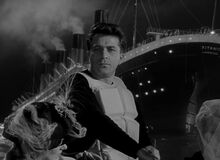
Robert Hitchens in A Night to Remember (1958)
Robert Hitchens was portrayed by Arthur Gross in A Night to Remember (1958)
1996 Titanic Miniseries
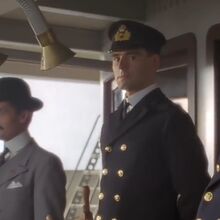
Robert Hitchens in 1996 Miniseries Titanic
Robert Hitchens was portrayed by Martin Evans. Hitchens behaviour on Lifeboat 6 was portrayed correctly in this miniseries.
1997 Titanic
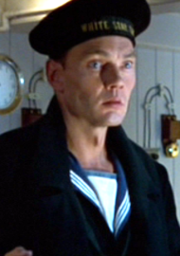
Robert Hichens in the 1997 Film

Robert Hichens in The Legend of the Titanic (1999)
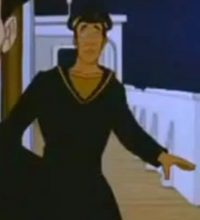
Robert Hichens in Titanic The Legend Goes On (2000)
His conduct was also noticeable in the 1997 blockbuster, Titanic, in which he was played by Paul Brightwell. He was depicted as a tall thin man with a cockney accent when in fact he was 5' 6", had a stocky build and spoke with a pronounced Cornish accent. He was also shown to have said "shut that hole in your face" but in fact those words were spoken by a steward in lifeboat 8.
2012 Miniseries Titanic
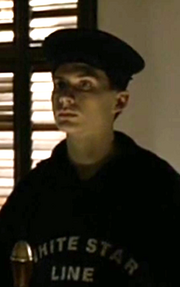
Robert Hichens in the 2012 Miniseries
In the 2012 Miniseries Titanic, Hichens is only seen in Episode 4, executing the hard-a-starboard order. He also acknowleged the order before he started turning the wheel. Furthermore, the fictional Seaman Holmes (Luke Norris) is based on him. Holmes also refuses to go back to the disaster site, and he is also treatened to be thrown overboard.
After death
In September 2010, Hichens' name was brought back into the limelight by Louise Patten, granddaughter of the most senior officer to have survived the Titanic disaster, second officer Charles Lightoller. In press interviews leading up to the publication of her latest novel, Good as Gold (into which she has worked the story of the catastrophe), Patten reports that a "straightforward" steering error by Hichens, brought about by his misunderstanding of a tiller order, caused the Titanic to hit an iceberg in 1912. Patten's allegation that Hichens caused the disaster by turning the ship's wheel the wrong way is not supported by testimony at both the British and U.S. enquiries, which established that the third of three watch officers, Sixth Officer Moody, was stationed behind Hichens, supervising his actions, and he had confirmed to Murdoch that the order had been carried out correctly.
The claim was also disputed by Hichens's great granddaughter on Channel 4 News. Sally Nilsson explained that Hichens was a well trained Quartermaster with years of experience steering large vessels. He had been responsible on his watch for steering the Titanic for four days before the collision and would not have made such a glaring error. As to the steering orders, in 1912 they were as follows: There was only one way of giving steering orders. The order was always given with reference to the tiller. To go to port the Officer ordered starboard. The Quartermaster turned the wheel to port, tiller went to starboard and the ship turned to port. This was a hangover from the old days when ships were steered with tillers, steering oars etc. The change in steering orders did not occur until 1924. Sally Nilsson's biography on the life of Robert Hichens will be published in 2011.
| ||||||||||||||
